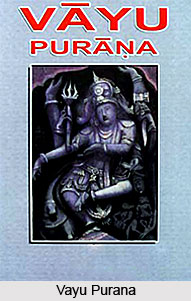 Vayu Purana is believed to belong to 600 AD. The text is divided into four parts: Prakriya-pada, Anushanga-pada, Upodghata-pada and Upasamhara-pada. This religious text deals with creation and re-creation of universe; measurement of time; Origin of Lord Agni, Lord Varuna and other gods; origin and descendants of Atri, Bhrigu, Angiras and other sages, daityas, rakshasas, gandharvas and pitrs; origin of animals, birds, trees and creepers; genealogies of the ancient kings starting from Vaivasvata Manu ending with the Gupta dynasty; geography of the earth; accounts of inhabitants of different dvipas; names and description of seven netherworlds; description of the solar system and the movements of the celestial bodies; description of the four yugas and fourteen manvantaras.
Vayu Purana is believed to belong to 600 AD. The text is divided into four parts: Prakriya-pada, Anushanga-pada, Upodghata-pada and Upasamhara-pada. This religious text deals with creation and re-creation of universe; measurement of time; Origin of Lord Agni, Lord Varuna and other gods; origin and descendants of Atri, Bhrigu, Angiras and other sages, daityas, rakshasas, gandharvas and pitrs; origin of animals, birds, trees and creepers; genealogies of the ancient kings starting from Vaivasvata Manu ending with the Gupta dynasty; geography of the earth; accounts of inhabitants of different dvipas; names and description of seven netherworlds; description of the solar system and the movements of the celestial bodies; description of the four yugas and fourteen manvantaras.
Vayu Purana also deals with music; various branches of the Vedas, Pashupata yoga, duties of the people of different castes and their funeral rites. Vayu Purana has detailed description of the Shaivas. In Vayu Purana the followers of Lord Shiva are described naked, covered with ash, with matted hair, begging for food, reclining in dirt and living in cemeteries. According to Vayu Purana the Puranas were originally recited by Lord Brahma. This text contains one hundred and twelve chapters. It is believed that this Purna has been so called as it was recited by the wind-god Vayu. In the Purana itself it has been mentioned that it was recited during the reign of King Adhisima Krishna.
This article is a stub. You can enrich by adding more information to it. Send your Write Up to content@indianetzone.com



















